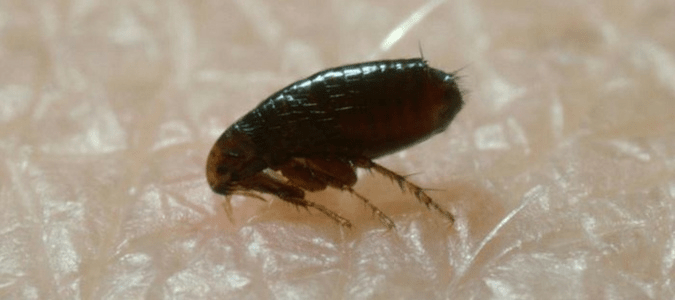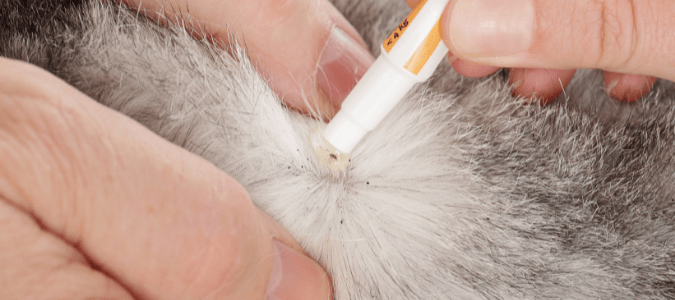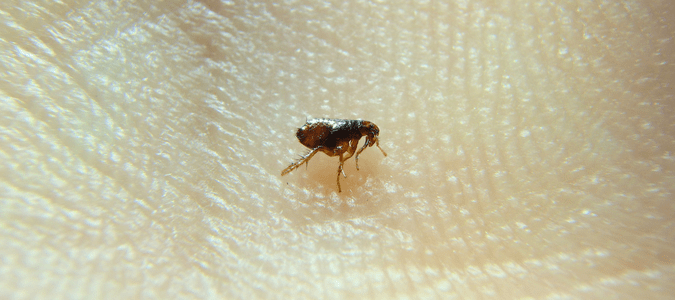If you have cats, you have probably noticed them using their feet to scratch an itchy spot or two. However if your kitty is scratching more than usual or licking and biting at their skin, they might have fleas. While some flea problems can be isolated to your pet, fleas are prolific breeders. And, as your cat walks around your home, they can deposit flea eggs wherever they go. Unfortunately, this can lead to a flea infestation throughout your home.
Cat fleas are the most common type of flea. They live all over the United States and around the world and mostly feed on dogs and cats, but will feed on other animals too. Cat fleas are tiny, coming in at about an eighth of an inch in length. They are brownish-black in color, but can appear red if they have recently fed. These pests are flat and wingless with 6 legs.
How to Look for Fleas on a Cat
If you think your cat has a flea problem, put them on their back and look around their armpits and groin. These are the most common places that fleas will hide because of their warmth and because they are more protected areas. Look for red patches or blood. Also, check your cat’s ears for the same markings or something that looks like dirt. All of these signs can indicate a flea infestation. If you are seeing any of these things, contact a veterinarian and a pest professional to get their expert opinion. If you aren’t seeing any redness, take a special flea comb and run it through your cat’s back hair and leg hair, getting close to the skin, to see if you pull any fleas out of hiding.
Of course, if you see small bugs hopping or crawling around in the cat’s fur, that is a sure sign that fleas have made your pet their home. It’s helpful to know what fleas look like to start. As previously mentioned, they are very small, just about an eighth of an inch in length, and can be tough to see. The fleas’ hind legs help them jump far and high for something so tiny. In fact, they can be tough to see on an animal because they can hop around on fur quickly.
Adult Fleas Aren’t the Only Problem
If you are seeing adult fleas on your cat, you should know that those represent about 5 percent of the fleas in your home. The others are living in different places in your home as eggs, larvae or pupae. Once fleas grow to adults, they live about two to four weeks but can live as long as four months. Every adult flea living on your cat will bite your furry friend up to 400 times a day.
Seeing fleas or the evidence that they are living on your pet means they might be in your bedding and furniture as well. Contact a veterinarian and a pest expert to learn about how they can help with pest control to get rid of the fleas and make your cats and your family comfortable again!
What is Flea Dirt on Cats?
As you might have guessed, flea dirt is not really dirt. If you are combing through your cat’s fur and seeing little black flecks, try this trick. Take a white piece of paper and place it near your cat while you are combing them. Any flecks will fall onto the paper. Add a drop of moisture to what lands on the paper. If the color changes to a reddish-brown, that is flea dirt.
Flea dirt is a lot easier to spot than actual fleas because it stays in one place unlike fleas, which love to jump all over the place and hide from you. Seeing flea dirt can give you a sign that your cat has a flea infestation before you find the actual fleas, so you can catch the problem earlier. If you spot flea dirt, contact a professional for pest control treatment.
You will most often find this flea dirt on your cat’s stomach or rear end, though it could be anywhere on your cat. It’s easier to see on dogs than on cats because felines spend so much time cleaning themselves. If the flea infestation has spread, you may also find this flea dirt on your couch, bedding and other furniture.
Small black spots can also be feline acne, so it’s important to know how to tell the difference. Feline acne can be caused by stress, bacteria or environmental allergens and irritants. It is most visible on the cat’s face, for the most part, whereas flea dirt is more toward the back and rear.
Look for little black dots between the cat’s hair follicles, a chin that looks dirty from spots and sometimes you might see what looks like zits on human skin on your cat. That’s feline acne, not flea dirt.
Can Dawn Dish Soap Kill Fleas?
There are several DIY strategies that people use to kill fleas, like using salt. One popular pet hack traveling around the internet is that dish soap, specifically one that touts its ability to clean wildlife, will take care of fleas on your cat. It might take them off for now, just as any bath with a good scrubbing would do. But, not without problems.
This particular dish soap actually drowns the fleas already on your cat. It does nothing to repel them or prevent your cat from getting covered in the pests again.
Dousing the fleas might be a good thing temporarily for your pet, but dish soap is meant for dishes, not for cats. Its formula breaks down grease, which means that when it comes into contact with skin, it removes the oils from the skin. That leads to dryness.
Dry skin isn’t a great thing for humans and it is even worse for cats. Because they have fur protecting their skin, felines have less oil. Oil is the skin’s natural defense, so removing it with dish soap leaves the skin prone to infection. For cats, that, in turn, leads to a lot of pain and itching that could send you to the veterinarian for testing and maybe even some antibiotics. That’s a pretty expensive bath.
Fleas Spread Fast
If you recall, adult fleas—the ones you can easily see—make up only about 5 percent of the total infestation in your home. The rest of the fleas are in your clothing, furniture, carpet and bedding. So giving your cat a bath helps for the moment but will not completely solve the problem.
Also of note, one adult flea can lay up to 50 eggs a day, which means an infestation can spread quickly. Even if you get rid of the pests you can see, just a few adults that escape can start the cycle all over again, possibly worse than before the bath.
A bath is a good part of an infestation-busting plan, but choose a soap meant for cats, and don’t expect that one action will cure the entire problem.
Cats aren’t the only ones affected by a home’s flea invasion. If they get into residents’ spaces, it is likely that you and your loved ones will get some bites in the night because the fleas will have taken up residence in your own bedding! Everything in your home needs cleaning to have a chance of getting rid of the infestation.
That is a lot of work! A pest control professional can pinpoint your flea problem, then recommend and implement the most effective solution for you and your space. This expert pest treatment can bring you, your family and your pets the relief that you so dearly long for.
Trust ABC To Handle Your Flea Problem
Don’t let a flea problem in your home disturb you or your furry family members. ABC Home & Commercial Services’ pest control specialists have a proven track record of diagnosing pest problems and handling them effectively. Our team members can treat fleas both indoors and outdoors and any other pests that threaten your quality of life. We will do a thorough inspection and develop a plan that works for you, your family and your lifestyle, so you can enjoy spending time at home.



